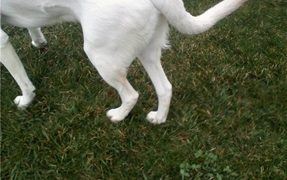“This post contains affiliate links, and I will be compensated if you make a purchase after clicking on my links.”
Does your dog have an unusual swing in his step, a limp, or does he appear to have pain in his back legs or hips? A well-known disorder that commonly affects medium to large size dogs is called Canine Hip Dysplasia. The term hip dysplasia basically refers to the laxity or looseness of the animal’s hip joint. This laxity allows partial dislocation or subluxation of the hip joint while the dog walks and carries weight on his hind limbs. This partial dislocation usually results in abnormal deterioration of the cartilage as well as the inflammation of the lining of the joint capsule brought about by stretching. This in turn leads to hip arthritis development at a fairly young age.
Causes
Quite a number of factors have been identified to cause the development of Canine Hip Dysplasia. These include nutritional factors, genetic influences, and some hormones found in the milk of the mother. Other unidentified causative factors are probably also responsible. No single influence alone, nonetheless, can be blamed for hip dysplasia development. However, food intake restriction has been revealed to minimize the manifestation of the condition among genetically predisposed dogs.
Hip Dysplasia has been confirmed in 179 of the 200 recognized breeds, so instead of listing dogs that are prone to the debilitating disease, it’s easier to list the ones that are not.
According to an article by Pam Brink for Yahoo!,
Breeds rarely seen in the United States are the Ainu, Braque, Canadian Eskimo dog,all four Chien breeds, Belgian Griffon, the English Coonhound or the Norbottenspets. They are not listed as having hip dysplasia.
Of the better known breeds, Terriers do not seem to be as frequently affected. The Hairless or Rat terrier, Irish Terrier, Sealyham Terrier, Shropshire Terrier, and the Toy Fox Terrier have no documented case of hip dysplasia.
The well-known breeds that have had no incidence of hip dysplasia are the Chihuahua, Havanese, and Papillon. All are very small dogs.
Diagnosis
Hip dysplasia is commonly diagnosed after signs of discomfort in the dog’s hind limbs are observed. Warning signs may include the animal’s difficulty or slowness in rising, limping on either one or both of the dog’s hind legs, reluctance to walk and play, or bunny-like hopping in the hind legs. Other means of diagnosis include performing a special maneuver to feel any laxity in the pet’s joint as well as by having the dog undergo several x-ray techniques such as the OFA or PennHIP views and the use of dorsolateral subluxation score. Only a veterinarian can officially diagnose hip dysplasia as the cause for your dog’s discomfort.
Treatment
There are several different treatments used to treat Canine Hip Dysplasia. One of these is through medical treatment which is basically a means to manage the symptoms of arthritis. This can be by way of weight control, use of anti-inflammatory prescriptions, and then exercise adjustment. Another treatment option includes surgery which could either be performed at a young age or a procedure carried out on a dog with severely arthritic joints. While the former category is a preventative procedure designed to help keep osteoarthritis from developing in loose hips, the latter, however, is a salvage procedure aimed at giving relief to the discomfort related to arthritis.
Aside from these, treatments like Triple Pelvic Osteotomy (TPO), Juvenile Pubic Symphysiodesis, Femoral Head and Neck Osteotomy (FHO), and Total Hip Replacement (THO) can also be some of the other proven options used to treat the condition.















เมดิลีน
Apr 21, 2014 at 10:06 am
Thanks for your marvelous posting! I actually enjoyed reading it, you’re a great author.
I will remember to bookmark your blog and will come back later on.
I want to encourage continue your great job, have a nice
evening!